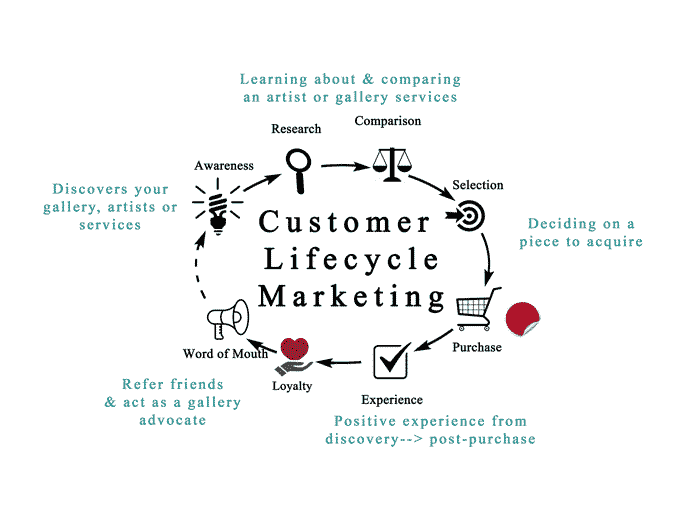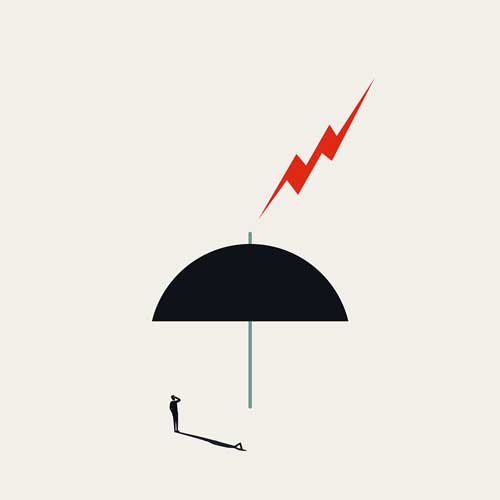Running an art gallery during tough economic times can be daunting. Discretionary spending is often the first to be cut, which can hurt an art gallery business. So, what does an action plan look like to ensure your gallery survives?
Churchill once said, “Never let a good crisis go to waste.” Even economic uncertainty can bring opportunities with the right marketing strategy. A successful gallery that weathers the storm will act proactively. It’s time to adjust spending and strategy to achieve optimal business results. In this article, we’ll discuss creating a gallery marketing action plan to tackle economic challenges.
Evaluate Your Gallery’s Best Assets
The best strategy is to stick with the marketing resources you already have. Focus on “always-on” marketing efforts, such as your gallery’s website SEO, social media, art sales platforms, or your existing mailing list. These typically have a more significant impact than developing something new and untested. Enhance these resources instead of creating new ones.
Consider where your best art sales leads are coming from. Identify your top-performing opportunities and resources that work well and don’t carry too much financial risk. Narrow your focus and pivot your energy towards accelerating these opportunities.
Depending on the economic downturn, some lead-generating sources may not be viable. For example, expensive art fairs or sales platforms may need to pause if sales don’t exceed expenditures. Decide what to keep and what to pause.
Lifecycle Gallery Marketing
“Always-on” marketing efforts move prospective art buyers from awareness to collectors and advocates of your gallery. Lifecycle marketing is about brand building with a strong value proposition. This could mean further developing your gallery’s brand through communications or your gallery program.
 Lifecycle marketing activities might include:
Lifecycle marketing activities might include:
- SEO
- Social media
- Brand awareness activities
- Paid advertising
- Marketing automation
- Email marketing
- Blogging
- Re-engagement campaigns
- Affiliate marketing or partnerships
- Referral or loyalty programs
- Third-party sales platforms
Evaluate each of these activities to determine where to focus your time and energy during tight times. Emphasize brand building and your value proposition. Promotion of your artists will continue, but may take on a softer selling tone.
Create an Art Gallery Recession Action Plan
To help your gallery survive a difficult economic climate, consider these six key steps. Some may need to be implemented before a crisis hits. These strategies can help maintain income and set the gallery up for a strong comeback when conditions improve.
1. Shift Your Gallery’s Marketing Message
Shift your marketing message from focusing on selling artists to showcasing your gallery program and services. Connect with your buyer’s values and needs. This shift will help you:
- Build gallery brand equity
- Show empathy for clients and artists
- Cast a wider net for awareness
Your buyers may also be struggling financially. Choose messaging that shows empathy and demonstrates how the gallery supports the community, clients, and artists.
2. Create Educational and Entertaining Content
Share untold or rarely told stories through gallery content. Communicate stories that build brand awareness and reflect value for prospective buyers. Content creation becomes more impactful during a recession. Increase content from your gallery as a soft-selling technique that resonates with collectors.
Create long-form blog posts, short videos, Instagram stories, etc. Increase gallery brand-forward content by at least 20%. Promote new content in your regular newsletters without overloading your email list.
3. Diversify Your Art Gallery’s Revenue Streams
Surviving a recession may require creating new revenue streams, even temporarily. Consider these ideas:
- Sell secondary works from collectors
- Promote the gallery as a rental space
- Offer collection management packages
- Develop an art rental service for commercial clients
- Charge artists an upfront exhibition fee with a lower sales commission
- Create a paid lecture series or workshops
- Add a shop with unique items like affordable jewelry or home goods
Diversifying income sources beyond art sales commissions can ease financial pressure. Some ideas may require advanced planning and a slight business model pivot.
4. Adjust Your Art Offering
After an economic downturn, your target market may prioritize paying off debts before buying art. Offer less expensive artworks by current artists or introduce new emerging artists with lower price points. Unique items from a gallery shop with high profit margins could be easier for buyers to justify.
Promote new artists as available for a limited time or as a special offering. Ensure selected artists fit your gallery’s program. Get feedback and recommendations from artists you represent.
5. Set a Budget for Gallery Advertising Post-Recession
As the recession ends, collectors will be more comfortable buying art again. Increase marketing spending to catch up. Plan campaigns for when conditions return to normal. This is the time to reintroduce a sales tone and leverage the brand equity you’ve built.
6. Gallery Emergency Fund
Create an emergency savings account separate from your regular business account. Contribute a little each month to help you through tough times or bounce back when they end. Creating an emergency fund makes good fiscal sense.
To the Point
History shows we can’t predict when a recession will hit or its impact on your gallery business. Marketing an art gallery during these times requires planning. You won’t have time to figure out what to do once sales dry up.
Regardless of the recession’s cause, you need a plan that can be quickly implemented. This plan should include changes to your business model that strengthen your ability to survive a crisis. Having a “go-to” plan helps you invest time and money wisely during a recession. Focus on your gallery’s best marketing channels for generating sales leads. Shift your marketing message to have an empathetic tone and showcase your gallery’s program and values.
Consider adding new revenue streams to your business. Crisis or not, it’s a good idea for the future. I want to see your gallery thrive in good times and bad. If you’d like to discuss your gallery’s situation, let’s set up an appointment.
These articles may also be helpful.
Business Development Strategies for Art Galleries in a Difficult Economy
Five Priorities for Marketing a New Art Gallery




Leave a Reply